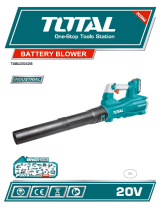
GENERAL SAFETY PRECA
UTIONS
English
–
7
General po
wer tool safety
warnings
Please read the oper
ator’s manual carefully and make
sure you understand the instructions before using the
machine.
Chec
k before starting
•
Always remove the battery to prevent the machine
being started by accident. Always remove the battery
before any maintenance on the machine.
• Before using the machine and after any impact, check
for signs of wear or damage and repair as necessary.
• Inspect the working area. Remove all loose objects,
such as stones, broken glass, nails, steel wire, string,
etc. that could be thrown out.
• The machine operator must ensure that no people or
animals come closer than 15 metres while working.
When several operators are working in the same area
the safety distance should be at least 15 metres.
• Carry out an overall inspection of the machine before
use. See the maintenance schedule.
P
ersonal safety
•
Stay alert, watch what you are doing and use
common sense when operating a power tool. Do
not use a power tool while you are tired or under
the influence of drugs, alcohol or medication.
A
moment of inattention while operating power tools
may result in serious personal injury.
• Keep bystanders away.
• This appliance is not intended for use by person
(including children) with reduced physical, sensory or
mental capabilities, or lack of experience and
knowledge, unless they have been given supervision
or instruction concerning use of the appliance by a
person responsible for their safety. Children should be
supervised to ensure that they do not play with the
appliance.
• Never allow children or other persons not trained in
the use of the machine and/or the battery to use or
service it. Local laws may regulate the age of the user.
• Keep unauthorised persons at a distance. Children,
animals, onlookers and helpers should be kept
outside the safety zone of 15 metres. Stop the
machine immediately if anyone approaches.
• Store the equipment in a lockable area so that it is out
of reach of children and unauthorized persons.
•
Dress properly. Do not wear loose clothing or
jewellery. Keep your hair, clothing and gloves
away from moving parts.
Loose clothes, jewellery or
long hair can be caught in moving parts.
• Never use the machine if you are tired, if you have
drunk alcohol, or if you are taking medication that
could affect your vision, your judgement or your co-
ordination.
• Wear personal protective equipment. See instructions
under the ”Personal protective equipment” heading.
• Turn off the machine when it has to be moved. Always
remove the battery when passing the machine to
another person.
• Keep in mind that it is you, the operator that is
responsible for not exposing people or their property
to accidents or hazards.
P
ower tool use and care
•
Never use a machine that has been modified in any
way from its original specification. Never use the
machine near explosive or flammable materials.
• Never use a machine that is faulty. Carry out the safety
checks, maintenance and service instructions
described in this manual. Some maintenance and
service measures must be carried out by trained and
qualified specialists. See instructions under the
Maintenance heading.
• Only use original spare parts.
• Always ensure that ventilation openings are kept clear
of debris.
• All covers, guards and handles must be fitted before
starting.
• Only use the machine in daylight or in other well-lit
conditions.
• Never use the machine in bad weather, for instance in
fog, in rain, damp or in wet locations,strong winds,
intense cold, risk of lightning, etc. Extremely hot
weather may cause overheating of the machine.
• If the machine starts vibrating abnormally, stop the
machine and remove the battery.
• Walk, never run.
Al
ways use common sense
It is not possib
le to cover every conceivable situation you
can face. Always exercise care and use your common
sense. Avoid all situations which you consider to be
beyond your capability. If you still feel uncertain about
operating procedures after reading these instructions,
you should consult an expert before continuing.
!
W
ARNING! Read all safety warnings and
all instructions. Failure to follow the
warnings and instructions may result in
electric shock, fire and/or serious injury.
IMPOR
TANT!
Save all warnings and instructions for
future reference.




















